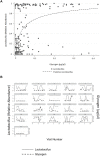Free glycogen in vaginal fluids is associated with Lactobacillus colonization and low vaginal pH
- PMID: 25033265
- PMCID: PMC4102502
- DOI: 10.1371/journal.pone.0102467
Free glycogen in vaginal fluids is associated with Lactobacillus colonization and low vaginal pH
Abstract
Objective: Lactobacillus dominates the lower genital tract microbiota of many women, producing a low vaginal pH, and is important for healthy pregnancy outcomes and protection against several sexually transmitted pathogens. Yet, factors that promote Lactobacillus remain poorly understood. We hypothesized that the amount of free glycogen in the lumen of the lower genital tract is an important determinant of Lactobacillus colonization and a low vaginal pH.
Methods: Free glycogen in lavage samples was quantified. Pyrosequencing of the 16S rRNA gene was used to identify microbiota from 21 African American women collected over 8-11 years.
Results: Free glycogen levels varied greatly between women and even in the same woman. Samples with the highest free glycogen had a corresponding median genital pH that was significantly lower (pH 4.4) than those with low glycogen (pH 5.8; p<0.001). The fraction of the microbiota consisting of Lactobacillus was highest in samples with high glycogen versus those with low glycogen (median = 0.97 vs. 0.05, p<0.001). In multivariable analysis, having 1 vs. 0 male sexual partner in the past 6 months was negatively associated, while BMI ≥30 was positively associated with glycogen. High concentrations of glycogen corresponded to higher levels of L. crispatus and L. jensenii, but not L. iners.
Conclusion: These findings show that free glycogen in genital fluid is associated with a genital microbiota dominated by Lactobacillus, suggesting glycogen is important for maintaining genital health. Treatments aimed at increasing genital free glycogen might impact Lactobacillus colonization.
Conflict of interest statement
Figures



Similar articles
-
Glycogen availability and pH variation in a medium simulating vaginal fluid influence the growth of vaginal Lactobacillus species and Gardnerella vaginalis.BMC Microbiol. 2023 Jul 13;23(1):186. doi: 10.1186/s12866-023-02916-8. BMC Microbiol. 2023. PMID: 37442975 Free PMC article.
-
Exploratory comparison of vaginal glycogen and Lactobacillus levels in premenopausal and postmenopausal women.Menopause. 2015 Jul;22(7):702-9. doi: 10.1097/GME.0000000000000397. Menopause. 2015. PMID: 25535963 Free PMC article.
-
Identification and characterisation of vaginal lactobacilli from South African women.BMC Infect Dis. 2013 Jan 26;13:43. doi: 10.1186/1471-2334-13-43. BMC Infect Dis. 2013. PMID: 23351177 Free PMC article.
-
Vaginal microbiome.Ceska Gynekol. 2018 Winter;83(5):371-379. Ceska Gynekol. 2018. PMID: 30848142 Review. English.
-
The human vaginal microbial community.Res Microbiol. 2017 Nov-Dec;168(9-10):811-825. doi: 10.1016/j.resmic.2017.08.001. Epub 2017 Aug 26. Res Microbiol. 2017. PMID: 28851670 Review.
Cited by
-
Exploring profile and potential influencers of vaginal microbiome among asymptomatic pregnant Chinese women.PeerJ. 2019 Dec 10;7:e8172. doi: 10.7717/peerj.8172. eCollection 2019. PeerJ. 2019. PMID: 31844576 Free PMC article.
-
Relationship between vitamin D status and the vaginal microbiome during pregnancy.J Perinatol. 2019 Jun;39(6):824-836. doi: 10.1038/s41372-019-0343-8. Epub 2019 Mar 11. J Perinatol. 2019. PMID: 30858609 Free PMC article. Clinical Trial.
-
Dysbiosis of the Vaginal Microbiota and Higher Vaginal Kynurenine/Tryptophan Ratio Reveals an Association with Chlamydia trachomatis Genital Infections.Front Cell Infect Microbiol. 2018 Jan 18;8:1. doi: 10.3389/fcimb.2018.00001. eCollection 2018. Front Cell Infect Microbiol. 2018. PMID: 29404279 Free PMC article.
-
Crosstalk Between Female Gonadal Hormones and Vaginal Microbiota Across Various Phases of Women's Gynecological Lifecycle.Front Microbiol. 2020 Mar 31;11:551. doi: 10.3389/fmicb.2020.00551. eCollection 2020. Front Microbiol. 2020. PMID: 32296412 Free PMC article.
-
The impact of theory-based education on promoting urinary tract infection prevention behaviours among elderly diabetic women - experimental study.Prz Menopauzalny. 2024 Mar;23(1):41-52. doi: 10.5114/pm.2024.136963. Epub 2024 Mar 28. Prz Menopauzalny. 2024. PMID: 38690068 Free PMC article.
References
-
- Antonio MA, Hawes SE, Hillier SL (1999) The identification of vaginal Lactobacillus species and the demographic and microbiologic characteristics of women colonized by these species. J Infect Dis 180: 1950–1956. - PubMed
-
- Giorgi A, Torriani S, Dellaglio F, Bo G, Stola E, et al. (1987) Identification of vaginal lactobacilli from asymptomatic women. Microbiologica 10: 377–384. - PubMed
-
- Boskey ER, Cone RA, Whaley KJ, Moench TR (2001) Origins of vaginal acidity: high D/L lactate ratio is consistent with bacteria being the primary source. Hum Reprod 16: 1809–1813. - PubMed
Publication types
MeSH terms
Substances
Grants and funding
LinkOut - more resources
Full Text Sources
Other Literature Sources
Medical
Miscellaneous

